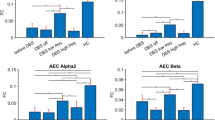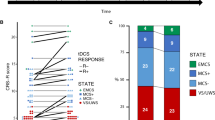Abstract
Replying to: H. Staunton Nature 452, 10.1038/nature06574 (2008)
Staunton1 highlights prior work applying deep-brain stimulation (DBS) in related thalamic and other subcortical structures in vegetative-state patients. We focused on patients who have plateaued at the upper end of the minimally conscious state at least one year after injury2, a group distinct from patients remaining in or just above vegetative state within the low end of the minimally conscious state. Patients remaining in a chronic vegetative state have anatomic pathology consistent with widespread neuronal death and cerebral disconnection3. In these patients, forebrain structures within the corticostriatopallidal–thalamocortical systems have been overwhelmingly damaged .
This is a preview of subscription content, access via your institution
Access options
Subscribe to this journal
Receive 51 print issues and online access
$199.00 per year
only $3.90 per issue
Buy this article
- Purchase on Springer Link
- Instant access to full article PDF
Prices may be subject to local taxes which are calculated during checkout
Similar content being viewed by others
References
Staunton, H. Arousal by stimulation of deep-brain nuclei. 452, 10.1038/nature06574 (2008)
Schiff, N. D. et al. Behavioural improvements with thalamic stimulation after severe traumatic brain injury. Nature 448, 600–603 (2007)
Adams, J. H., Graham, D. I. & Jennett, B. The neuropathology of the vegetative state after acute insult. Brain 123, 1327–1338 (2000)
Hassler, R., Dalle Ore, G., Dieckmann, G., Bricolo, A. & Dolce, G. Behavioural and EEG arousal induced by stimulation of unspecific projection systems in a patient with post-traumatic apallic syndrome. Electroencephalogr. Clin. Neurophysiol. 27, 306–310 (1969)
Cohadon, F. et al. in Neurostimulation: An Overview (eds Lazorthes, Y. & Upton, A. R. M.) 247–250 (Futura Publishers, Mt Kisco, New York, 1985)
Tsubokawa, T. et al. Deep-brain stimulation in a persistent vegetative state: Follow-up results and criteria for selection of candidates. Brain Inj. 4, 315–327 (1990)
Pfaff, D. Brain Arousal and Information Theory (Harvard Univ. Press, Cambridge, Massachusetts, 2005)
The Multi-Society Task Force on PVS. Medical aspects of the persistent vegetative state (1). N. Engl. J. Med. 30, 1499–1508 (1994)
Jennett, B. The Vegetative State (Cambridge Univ. Press, Cambridge, UK, 2002)
Yamamoto, T. & Katayama, Y. Deep brain stimulation therapy for the vegetative state. Neuropsychol. Rehabil. 15, 406–413 (2005)
Giacino, J. T. & Kalmar, K. The vegetative and minimally conscious states: a comparison of clinical features and functional outcome. J. Head Trauma Rehabil. 12, 36–51 (1997)
Lammi, M. H., Smith, V. H., Tate, R. L. & Taylor, C. M. The minimally conscious state and recovery potential: A follow-up study 2 to 5 years after traumatic brain injury. Arch. Phys. Med. Rehabil. 86, 746–754 (2005)
Schiff, N. D. & Purpura, K. P. Towards a neurophysiological basis for cognitive neuromodulation. Thalamus Relat. Syst. 2, 55–69 (2002)
Author information
Authors and Affiliations
Rights and permissions
About this article
Cite this article
Schiff, N., Giacino, J., Kalmar, K. et al. Schiff et al. reply. Nature 452, E1–E2 (2008). https://doi.org/10.1038/nature06575
Issue Date:
DOI: https://doi.org/10.1038/nature06575
Comments
By submitting a comment you agree to abide by our Terms and Community Guidelines. If you find something abusive or that does not comply with our terms or guidelines please flag it as inappropriate.



